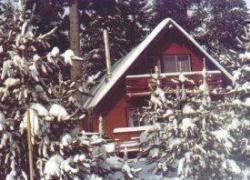Tahoe Residents Seethe At Greenies
 Richard Carlson looks out his Tahoe cabin window at the beautiful view knowing that if he sees forest fire smoke below him, he has 10 minutes to clear out before the fire will block his only exit route. Carlson therefore knows a thing or two about managing forests for optimum fire safety. Why?
Richard Carlson looks out his Tahoe cabin window at the beautiful view knowing that if he sees forest fire smoke below him, he has 10 minutes to clear out before the fire will block his only exit route. Carlson therefore knows a thing or two about managing forests for optimum fire safety. Why?Behind my home, it's nearly impossible to hike off trail because you have to wade through knee-deep piles of dead branches.
The forest is ready to explode. We have too many trees, but no one dares do anything about it.
It's not a pretty thing, this forest management debate. Lumber company and radical environmentalists have staked out the extreme positions, with the Forest Services, forest residents and mainstream conservationists in between.
Reasonable people know the forest has to be thinned. People educated on the matter know that when the first photographers lugged cameras up the Sierras, the photos they took showed forests remarkably thinner than those today. And environmentalists know they'll always be able to make a buck by railing against loggers.
Against that backdrop, an agreement was struck to allow the sort of environmentally balanced thinning that might have prevented the Tahoe fire. It didn't pan out, says Carlson in an SF Chronicle opinion piece today:
Effective but environmentally safe forest thinning requires compromise between environmentalists and commercial loggers. Unfortunately, the new, more ideological environmental movement refuses such compromise. This refusal is exemplified by the Quincy Library Group.
The group drafted an agreement among Sierra conservationists, industry and political leaders that would have allowed enough controlled commercial thinning of Sierra forests to actually make a dent in the deadly growing forest fuel loads. The agreement was killed by lawsuits from the new, more radical urban environmentalists who value money and ideology above science, homes and human life.
The leaders of such groups as California's chapters of the Sierra Club knew that their urban constituencies could be depended on to contribute to any anti-logging campaign.
Compromise would lose money and support to more-radical groups. Having spent decades creating the image of the evil logger as their favorite fundraiser, the urban environmentalists didn't dare be caught talking to one. Allied as the Sierra Forest Legacy, these organizations have largely stopped effective efforts to deal with the fast-growing fire danger in Sierra forests.
It's not like there hasn't been sufficient time to implement the recommendations of the Quincy Library Group's agreement; it was inked in 1993, and DiFi submitted legislation in 1998. But nothing has happened except more of the insane status quo:
It's the same all over, and not just with the fires that preceded in Arizona and elsewhere. The California Coastal Commission forbids the repair or building of sea walls. A farmer in San Bernardino County was arrested for plowing a fire-break around his home because Stevens kangaroo rats might have been disturbed.While the lawyers argue, and the environmental fundraisers happily collect their tribute, the forest fuel loads keep growing.
In Tahoe, the situation is exacerbated by the Tahoe Regional Planning Agency (known locally as the Tree Nazis). The agency's rules override fire marshal guidelines and generally make desperately needed tree thinning impossible. Unless you go through an insanely complex, expensive and lengthy permit process, you can't touch a tree that's larger than 6 inches in diameter, even if it's next to your house. And 6- to 12-inch firs are exactly the type of tree that is the greatest fire danger.
One of my clients recently spent $3 million fighting off (successfully) a Center for Biological Diversity lawsuit over air quality. Ironically, the project was able to fully mitigate its air quality impacts for one-sixth that amount, just $500,000, with which they bought new, clean diesel generators to replace dirty generators used by farmers in the area.
The Center didn't care. This client is a major fundraising source for them and like radical green groups everywhere, solutions aren't their goal; power and money is.
If people die and cabins burn because of their goals, so what? The world in their view is better without people and cabins anyway.
Labels: Environmentalism, Government, Regulation




<< Home